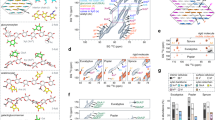Abstract
Nanostructures consisting of the biomass constituents of the denatured Japanese cypress (Chamaecyparis obtusa) were examined by instrumental analyses at multiple hierarchical levels. Delignification with NaClO2 solution smoothly proceeded to reveal a distorted cell by scanning electron microscopy; however, a trace amount of lignin still remained in the delignified sample according to attenuated total reflection infrared spectra (ATR-IR). Although hemicellulose could be removed by a treatment with NaOH solution, thermogravimetric analysis and 13C cross-polarization/magic angle spinning (CP-MAS) NMR showed a certain amount of hemicellulose remaining. Reaction of the delignified sample with NaOH solution produced a shrunken cell wall that consisted of cellulose with small amounts of lignin and hemicellulose, which were detected by ATR-IR and 13C CP-MAS NMR, respectively. These samples from which lignin and/or hemicellulose had been removed easily released water molecules, producing a decrease in the 1H signal intensity and longer 1H spin–lattice relaxation time (T1H) values in variable temperature 1H MAS NMR. The T1H values provided information about nano-scale molecular interaction difficult to obtain by other instrumental analyses and they greatly changed depending on the water content and ratio of the biomass constituents. The spin–lattice relaxation of all samples occurred via water molecules under humid conditions that provided sufficient water. Under heat-dried conditions, the spin–lattice relaxation mainly occurred via lignin for the samples with lignin remaining while it occurred via cellulose/hemicellulose for the samples without lignin. The variable temperature T1H analysis indicated that predominant spin–lattice relaxation route via lignin was caused by higher molecular mobility of lignin-containing samples compared with lignin-free samples.













Similar content being viewed by others
References
Acharjee TC, Coronella CJ, Vasquez VR (2011) Effect of thermal pretreatment on equilibrium moisture content of lignocellulosic biomass. Bioresour Technol 102:4849–4854. doi:10.1016/j.biortech.2011.01.018
Barneto AG, Carmona JA, Alfonso JEM, Alcaide LJ (2009) Use of autocatalytic kinetics to obtain composition of lignocellulosic materials. Bioresour Technol 100:3963–3973. doi:10.1016/j.biortech.2009.03.048
Bergenstråhle M, Wohlert J, Larsson PT, Mazeau K, Berglund LA (2008) Dynamics of cellulose-water interfaces: NMR spin-lattice relaxation times calculated from atomistic computer simulations. J Phys Chem B 112:2590–2595. doi:10.1021/jp074641t
Brandt A, Gräsvik J, Hallett JP, Welton T (2013) Deconstruction of lignocellulosic biomass with ionic liquids. Green Chem 15:550–583. doi:10.1039/c2gc36364j
Doherty WOS, Mousavioun P, Fellows CM (2011) Value-adding to cellulosic ethanol: lignin polymers. Ind Crops Prod 33:259–276. doi:10.1016/j.indcrop.2010.10.022
Engelund ET, Thygesen LG, Svensson S, Hill CAS (2013) A critical discussion of the physics of wood-water interactions. Wood Sci Technol 47:141–161. doi:10.1007/s00226-012-0514-7
Esteves BM, Pereira HM (2009) Wood modification by heat treatment: a review. BioResources 4:370–404
Felby K, Thygesen LG, Kristensen JB, Jørgensen H, Elder T (2008) Cellulose–water interactions during enzymatic hydrolysis as studied by time domain NMR. Cellulose 15:703–710. doi:10.1007/s10570-008-9222-8
Froix MF, Goedde AO (1976) The effect of temperature on the cellulose/water interaction from NMR relaxation times. Macromolecules 9:428–430. doi:10.1021/ma60051a009
Fung BM, Khitrin AK, Ermolaev K (2000) An improved broadband decoupling sequence for liquid crystals and solids. J Magn Reson 142:97–101. doi:10.1006/jmre.1999.1896
Hill CAS (2007) Wood modification: chemical, thermal and other processes, vol 5. Wiley, Hoboken. ISBN: 978-0-470-02172-9
Hill CAS, Norton A, Newman G (2009) The water vapor sorption behavior of natural fibers. J Appl Polym Sci 112:1524–1537. doi:10.1002/app.29725
Inagaki T, Siesler HW, Mitsui K, Tsuchikawa S (2010) Difference of the crystal structure of cellulose in wood after hydrothermal and aging degradation: a NIR spectroscopy and XRD study. Biomacromology 11:2300–2305. doi:10.1021/bm100403y
Kimmich R, Anoardo E (2004) Field-cycling NMR relaxometry. Prog Nucl Magn Reson Spectrosc 44:257–320. doi:10.1016/j.pnmrs.2004.03.002
Maunu SL (2002) NMR studies of wood and wood products. Prog Nucl Magn Reson Spectrosc 40:151–174. doi:10.1016/S0079-6565(01)00041-3
Metz G, Wu XL, Smith SO (1994) Ramped-amplitude cross polarization in magic-angle-spinning NMR. J Magn Reson A 110:219–227. doi:10.1006/jmra.1994.1208
Newman RH, Davidson TC (2004) Molecular conformations at the cellulose–water interface. Cellulose 11:23–32. doi:10.1023/B:CELL.0000014778.49291.c6
Nishida M, Tanaka T, Miki T, Shigematsu I, Kanayama K, Kanematsu W (2014) Study of nanoscale structural changes in isolated bamboo constituents using multiscale instrumental analyses. J Appl Polym Sci 131:40243. doi:10.1002/app.40243
Nishida M, Tanaka T, Miki T, Ito T, Kanayama K (2017) Multi-scale instrumental analyses for structural changes in steam-treated bamboo using a combination of several solid-state NMR methods. Ind Crops Prod 103:89–98. doi:10.1016/j.indcrop.2017.03.041
Olsson A-M, Salmén L (2004) The association of water to cellulose and hemicellulose in paper examined by FTIR spectroscopy. Carbohyd Res 339:813–818. doi:10.1016/j.carres.2004.01.005
Oltean L, Teischinger A, Hansmann C (2007) Influence of temperature on cracking and mechanical properties of wood during wood drying—a review. BioResources 2:789–811
Pandey KK (1999) A study of chemical structure of soft and hardwood and wood polymers by FTIR spectroscopy. J Appl Polym Sci 71:1969–1975. doi:10.1002/(SICI)1097-4628(19990321)71:12<1969::AID-APP6>3.0.CO;2-D
Park S, Johnson DK, Ishizawa CI, Parilla PA, Davis MF (2009) Measuring the crystallinity index of cellulose by solid state 13C nuclear magnetic resonance. Cellulose 16:641–647. doi:10.1007/s10570-009-9321-1
Peng F, Bian J, Peng P, Guan Y, Xu F, Sun R-C (2012) Fractional separation and structural features of hemicelluloses from sweet sorghum leaves. BioResoureces 7:4744–4759
Schwanninger M, Rodrigues JC, Pereira H, Hinterstoisser B (2004) Effects of short-time vibratory ball milling on the shape of FT-IR spectra of wood and cellulose. Vib Spectrosc 36:23–40. doi:10.1016/j.vibspec.2004.02.003
Tekin K, Karagöz S, Bektaş S (2014) A review of hydrothermal biomass processing. Renew Sust Energ Rev 40:673–687. doi:10.1016/j.rser.2014.07.216
Thybring E (2013) The decay resistance of modified wood influenced by moisture exclusion and swelling reduction. Int Biodeter Biodegr 82:87–95. doi:10.1016/j.ibiod.2013.02.004
Wang Y, Minato K, Iida I (2006) Mechanical properties of wood in an unstable state due to temperature changes, and analysis of the relevant mechanism II. Selective and uniform elimination of chemical constituents from wood blocks. Mokuzai Gakkaishi 52:168–172
Willis JM, Herring FG (1987) Effect of water in the 13C CP/MAS NMR spectrum of white spruce wood. Macromolecules 20:1554–1556. doi:10.1021/ma00173a020
Author information
Authors and Affiliations
Corresponding author
Electronic supplementary material
Below is the link to the electronic supplementary material.
Rights and permissions
About this article
Cite this article
Nishida, M., Tanaka, T., Miki, T. et al. Instrumental analyses of nanostructures and interactions with water molecules of biomass constituents of Japanese cypress. Cellulose 24, 5295–5312 (2017). https://doi.org/10.1007/s10570-017-1507-3
Received:
Accepted:
Published:
Issue Date:
DOI: https://doi.org/10.1007/s10570-017-1507-3




